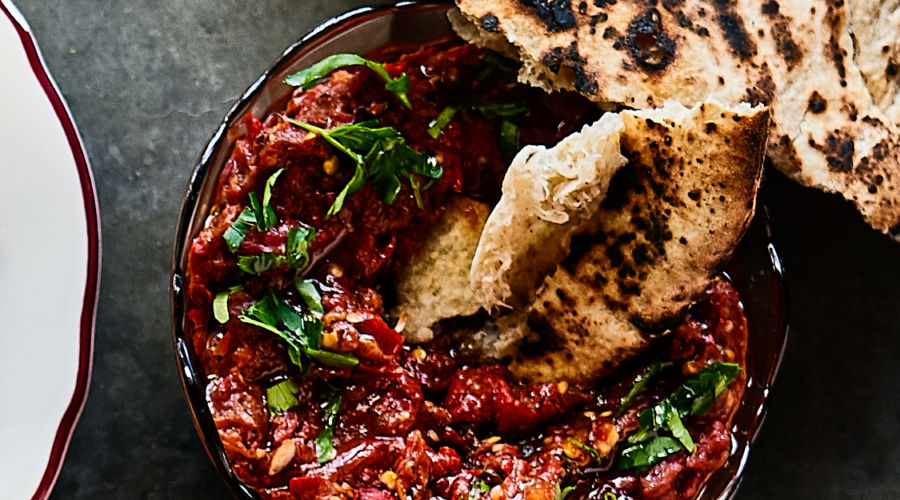Lutenitsa

Home cooks can save time by buying roasted peeled peppers in a jar. Recipe author Alon Shaya suggests Spanish piquillo peppers, which are a little bit more intense in flavor.
How to Make It
Set the peppers on their sides over high heat on a gas burner or grill so they’re exposed directly to the flame (if you’ve got one, use a small metal grate to keep them from falling into the burner so that they char more evenly). Cook until that side is completely blackened, 3 to 4 minutes, then rotate; they’re done when they’re charred black all over. Remove from heat and set aside to cool.
Use a fork to prick the eggplant a few times all over. It gives off a fair amount of liquid as it cooks, so if you like, line your burner with foil for easy cleanup. Lay the eggplant on its side over the burner, as you did with the peppers, and cook over medium-high heat until the side is blistered and blackened with bits of papery white char. Rotate and keep cooking until the whole thing is uniformly charred; depending on your stove, this usually takes about 45 minutes. The eggplant will be ugly, and you’ll think you overcooked it—you didn’t. This is what gives it a ton of flavor and a creamy texture. Remove from heat and set aside to cool.
When the peppers are cool enough to handle, use wet fingers to rub off all their papery, charred skin. Resist the urge to run them under water; although that allows you to peel them faster, it also rinses away the smoky flavor you just built. Once the skins are removed, pull or cut out the stems, halve the peppers lengthwise, and scrape out the seeds and any pith. Chop the peppers and set them aside; you should have about 1 1⁄2 cups’ worth.
Halve the eggplant lengthwise and cut off the top. The inside should be creamy all the way to the center, but if it’s not, you can finish the job by placing the halved eggplant in a 375° oven for 5 to 10 minutes. Use a spoon to gently scoop out the flesh, taking care not to bring too much charred skin with it, and set the flesh aside with the peppers; you should have about 3⁄4 cups’ worth.
Set a large sauté pan over medium heat and add 2 tbsp. oil. Once it’s warm, add the tomato paste and use a wooden spoon or spatula to break it up as much as you can to build a toasty flavor.
Once the oil is orange and the tomato paste doesn’t smell so raw, add the garlic and cook just until it starts to soften and smell great, about 3 minutes. Add the roasted peppers, eggplant, and salt and stir to incorporate. Roughly crush the canned tomatoes by hand, or chop them, then add them to the pan with their juice.
Reduce the heat to low and cook, uncovered, for about 1 hour. You want the mixture to really dry out, thicken, and kind of slump into itself. Stir it occasionally to scrape up the brown bits and prevent the bottom of the pan from burning. It’s done when it tastes sweet and deeply caramelized. Set it aside and let cool to room temperature. To serve, scatter with parsley and drizzle with the remaining 2 tablespoons of oil. Serve with pita bread or crudites alongside, or spread it on a sandwich or toast.

